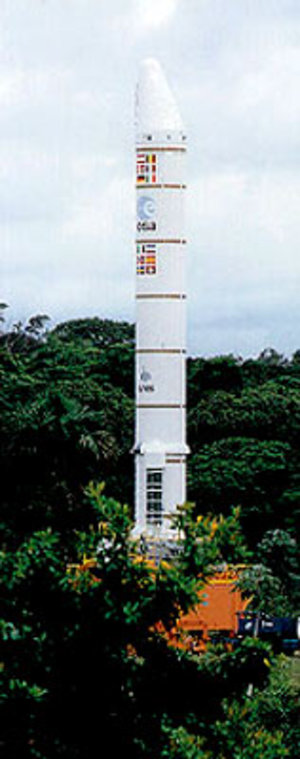Ariane 5 Speltra and Sylda 5
Ariane 5, like its Ariane 4 predecessor, was designed to carry dual-satellite launches. To do this the upper stage could be equipped with one of two structures: the Speltra or the Sylda 5. These were positioned above the upper stage inside the fairing.
Speltra
One satellite was placed inside the Speltra while the other was mounted on top of the Speltra, inside the fairing.

The Speltra came in a long version weighing 820 kg and a short version weighing 704 kg. Both could accommodate two satellites with an upper satellite weighing up to 4500 kg. The Speltra was conical at the bottom and had a cylindrical structure on top.
The widest part of the cone had a diameter of 5.40 m, the same as the launcher's main stage. The cylindrical section of the 'short' Speltra was 4.1 m high and the 'long' version was 5.6 m high. Both had a 1.3 m high truncated conical section which was 2.6 m in diameter at the top. This supported a second payload adapter interface to which the second satellite could be attached.
In addition to carrying the satellites, the Speltra also protected them before the launch. To do this the Speltra received a constant flow of dry air via an umbilical ground line to keep the satellite inside cool until liftoff. It also had built-in hatches around the circumference to allow access to internal equipment and to the satellite's electrical connectors.
Sylda 5

The Sylda 5 was housed inside the fairing. At the bottom it had a 50 cm cone which interfaced with the vehicle equipment bay. The Sylda 5 was smaller than the Speltra; the cylinder was 4.5 m in diameter and 3.2 m high, while the cone above was 1 m high and ended in the 2.6 m diameter of the standard payload interface. When empty the Sylda 5 weighed 440 kg.
During a standard dual-launch mission, the upper satellite was released first. Then, the Speltra or Sylda-5 was jettisoned in order to release the second satellite. Both systems had pyrotechnic separation systems at their base and push-off springs.
Separation was triggered by two detonators which severed the steel attachment between the vehicle equipment bay and the Speltra or Sylda. The dual payload structure was then pushed away by means of eight special steel springs.
Responsible contractor: EADS Space















 Germany
Germany
 Austria
Austria
 Belgium
Belgium
 Denmark
Denmark
 Spain
Spain
 Estonia
Estonia
 Finland
Finland
 France
France
 Greece
Greece
 Hungary
Hungary
 Ireland
Ireland
 Italy
Italy
 Luxembourg
Luxembourg
 Norway
Norway
 The Netherlands
The Netherlands
 Poland
Poland
 Portugal
Portugal
 Czechia
Czechia
 Romania
Romania
 United Kingdom
United Kingdom
 Slovenia
Slovenia
 Sweden
Sweden
 Switzerland
Switzerland



































